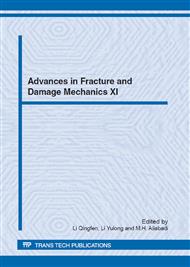p.193
p.197
p.201
p.205
p.209
p.213
p.217
p.221
p.225
Experimental Study of the Influence of the Initial Notch Length in Cubical Concrete Wedge-Splitting Test Specimens
Abstract:
The wedge-splitting test (WST) is a frequently used test configuration for performing stable crack fracture experiments on concrete specimens, thus allowing to determine the fracture process and crack propagation in the heterogeneous material. However, there are no standard rules regarding the wedge-splitting specimens geometry, groove dimensions or notch length. This paper concentrates on the influence of the initial notch length in geometrically identical, cubical specimens, cast from vibrated concrete. The experimental results of nine WSTs under monotonic loading, including Fsp-CMOD curves - splitting force versus crack mouth opening displacement - and fracture energy Gf, are presented. An important effect of the starting notch length on the fracture properties is observed.
Info:
Periodical:
Pages:
209-212
Citation:
Online since:
November 2012
Authors:
Keywords:
Price:
Сopyright:
© 2013 Trans Tech Publications Ltd. All Rights Reserved
Share:
Citation:


